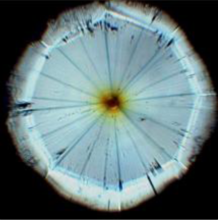High Pressure Researcher Mikhail Eremets (1949-2024)

Brief Description Of Scientific Achievements
Mikhail Eremets has achieved multiple seminal advances in high-pressure research, including the discovery of new phases and properties of elemental hydrogen, nitrogen, sodium and other substances. Most importantly, Eremets and his research team discovered superconductivity in hydrogen sulfide at temperatures above 200 K, which is much higher than previously observed for other materials.
Superconductivity Is a material property of high scientific and technological interest It enables the transport of electricity without resistance, which was first discovered in mercury cooled by liquid helium over a hundred years ago (Kamerling Onnes, 1911 ). For many years, superconductivity was observed only in metals at very low temperature ( < 30 K). After the discovery of superconducting ceramic materials 30 years ago (Bednorz and Muller, 1986), the critical temperature of superconductivity was raised up to ~160 K, however, over the past 20 years, no further increase had been achieved.
During the 1950s, phenomenological descriptions and microscopic theories of superconductivity were developed (Ginzburg, Landau, Abrikosov; Bardeen, Cooper, Schriefer). In 1968, Neil Ashcroft predicted that hydrogen should become a metal and a high-temperature superconductor under high pressure. To test and prove this hypothesis, Mikhail Eremets has designed and performed very challenging experiments over many years, investigating pure hydrogen as well as various types of hydrogen-rich compounds (hydrides). With extraordinary dedication, vision and skills, Eremets and his team have finally arrived at proving the existence of hydrogen-based high-ternperature superconductors.
In 2014/2015, Mikhail Eremets and collaborators discovered and characterized a new, very simple material that exhibits superconductivity at substantially higher temperature than observed before. Eremets and his team developed advanced diamond anvil cells and related equipment allowing them to apply pressures of more than a million bar to hydrogen sulfide. At ambient pressure and temperature, hydrogen sulfide is a gas1 but at high pressure (150 GPa) this gas turns into a solid substance that exhibits superconductivity below 203 K, i.e., at temperatures that can be reached by cooling with dry ice. Eremets and colleagues have shown that this materiaI conducts electricity without resistance and exhibits the Meissner and isotope effects, which are further characteristics of superconducting materials (Drozdov et al., Nature 2015). Recently, Mikhail Eremets and his research team achieved a breakthrough to near room temperature superconductivity in hydrogen-rich materials, i.e., at 250 Kin lanthanum hydride (Drozdov et al., Nature 2019).
Mikhail Eremets' research and findings have sparked enormous excitement in the physics and materials science community and triggered a wave of follow-up studies confirming and extending the results. The breakthrough of Eremets and colleagues and the renewed interest in the pursuit of conventional room temperature superconductivity are expected to advance the progress of science, technology, and society at large.
Honors and Awards
- Bernd T. Matthias Prize for superconducting materials 2022.
- Bodo-von-Borries Special lecture 2022
- James C. McGroddy Prize for New Materials of the American Physical Society's 2020.
- Breakthrough Winner in Physical Sciences, Falling Walls, Berlin 2020.
- The Bragg Lecture at University College London 2020.
- Bridgman Award AIRAPT 2017.
- Honorary Doctor Degree from Leipzig University, Germany 2016.
- Ugo Fano Gold Medal 2015.
- On the list of Nature’s 10: Ten people who mattered this year 2015.
- Fellow of IAAM (International Association of Advanced Materials) 2023
Selected Press Releases
- 24. Januar 2022, „Ehrung für den Supraleitungsforscher Mikhail Eremets – Physiker des Max-Planck-Instituts für Chemie in Mainz erhält den Bernd T. Matthias Preis für die Materialforschung zu Supraleitern“: https://www.mpic.de/5136800/eremets-bernd-matthias-preis
- 31. Oktober 2019, „Renommierter Preis für den Supraleitungsforscher Mikhail Eremets – Physiker des Max-Planck-Instituts für Chemie in Mainz erhält den James C. McGroddy-Preis für neue Materialien“: https://www.mpic.de/4498014/renommierter-preis-fuer-den-supraleitungsforscher-mikhail-eremets
- 23. Mai 2019, „Ein Sprung zur Supraleitung bei Raumtemperatur – Ein wasserstoffreiches Material wird unter hohem Druck bei minus 23 Grad Celsius supraleitend“: https://www.mpic.de/4389216/ein-sprung-zur-supraleitung-bei-raumtemperatur
- 6. September 2017, „Mit Hochdruck zur Supraleitung: Auszeichnung für Max-Planck-Wissenschaftler und neue Erkenntnisse – Mikhail Eremets vom MPI für Chemie wird für seine Leistungen in der Hochdruckforschung mit dem Bridgman Award geehrt und zeigt Erfolge bei der Erzeugung von metallischem Wasserstoff“: https://www.mpic.de/4467122/mit-hochdruck-zur-supraleitung
- 17. Dezember 2015, „Max-Planck-Forscher geehrt und in Nature‘s Top Ten – Wissenschaftsorganisationen und Journale zeichnen Mikhail Eremets für seine Arbeiten zur Supraleitung aus“: https://www.mpic.de/3858715/max-planck-forscher-geehrt-und-in-nature-s-top-ten
- 17. August 2015, „Supraleitung: Widerstandslos bei Rekordtemperaturen – Schwefelwasserstoff verliert seinen elektrischen Widerstand unter hohem Druck bei minus 70 Grad Celsius“: https://www.mpic.de/5259653/widerstandslos-bei-rekordtemperaturen
- 24. November 2010, „€ 1,9 Millionen EU-Forschungsförderung für Mikhail Eremets vom Max-Planck-Institut für Chemie – Dr. Mikhail Eremets hat Ende Oktober den „Advanced Grant“ des Europäischen Forschungsrates erhalten. Der Rat vergab die Summe von € 1,9 Millionen für die Erforschung von leitfähigem und metallischem Wasserstoff“: https://www.mpic.de/3918705/1-9-millionen-eu-forschungsfoerderung-fuer-mikhail-eremets-vom-max-planck-institut-fuer-chemie
Grants and Funding
- 2011-2016: "Exploring conductive and metallic hydrogen" €1.9 Million, European Research Council Advanced Grant
- 2010-2013: “Study of phase stability and low pressure synthesis of solid nitrogen with the help of atomic computer simulation and experiment”. DFG-grant (postdoc position). In cooperation with Darmstadt University (Prof. K. Albe)
- 2009-2012: “Phase diagram of ammonia up to 200 GPa” SPP1236 DFG-grant (postdoc position)
- 2010-2013: “Transport Measurements and Mößbauer Investigations of FeSe and related compounds under high pressure”, DFG grant SPP 1481. In collaboration with the Mainz Guttenberg university (Prof. C. Felser) - (postdoc
Short movie which gives an insight into the research of the Eremets group.

